Home > Digitized Walters Manuscripts
This document is a tranformation of a TEI P5 XML manuscript description incorporating images. If you have trouble reading special or non-Latin characters on this page, please make sure you have appropriate Unicode fonts installed and an up-to-date web browser.
Walters Ms. W.557, Koran
Browse images (Browse images in a new window) | TEI in XML format
W.557
Koran
Vernacular: القرآن
This copy of the Qur'an was made in Iran, probably in the sixth century AH / twelfth CE. The text is written in the New Abbasid (broken cursive) style with vowels indicated by red dots and orthoepic signs such as tashdīd and sukūn in green. The codex opens with an illuminated double-page frontispiece (fols. 1b-2a) inscribed with the creed that the Qur’an is God’s word uncreated: al-Qur’ān kalām Allāh ghayr makhlūq wa-man qāla makhlūq fa-huwa kāfir bi-Allāh al-ʿAlī al-Aẓīm. The latter is also included in the explicit (fol. 285a). The Qur’anic text begins with an illuminated incipit for chapter 1 (Sūrat al-fātiḥah) and chapter 2 (Sūrat al-baqarah) (fols. 2b-3a). Throughout are illuminated chapter headings with marginal medallions, verse markers in teardrop form, marginal medallions indicating every tenth verse, illumination of the name of Allah, and indications for prostration. The dentelle-style brown goatskin binding with central lobed medallion, pendants, and cornerpieces is attributable to the tenth century AH / sixteenth CE.
6th century AH / 12th CE
Iran
Book
Scriptural
The primary language in this manuscript is Arabic.
Paper
Laid paper with chain lines that appear to be grouped in twos
Foliation: i+285+i
Catchwords: None
Comments: Consists of quires averaging twelve folios each
20.5 cm wide by 34.5 cm high
14.0 cm wide by 23.0 cm high
- Columns: 1
- Ruled lines: 23
- Title: al-Qurʾān
- Hand note: Main text written in New Abbasid (broken cursive) style, partially serifed in dark brown ink with red dots for vowels and orthoepic signs, such as tashdīd and sukūn, in green; thuluth script in gold ink for the inscription on fols. 1b-2a
- Decoration note: Illuminated double-page frontispiece inscribed with the creed of the uncreatedness of the Qur’an in thuluth script in the upper and lower panels (fols. 1b-2a); double-page illuminated incipit for chapters 1 (Sūrat al-fātiḥah) and 2 (Sūrat al-baqarah) (fols. 2b-3a); double-page illuminated explicit (fols. 284b-285a), containing chapter 114 (Sūrat al-nās) (fol. 284b) and the creed of the uncreatedness of the Qur’an; illuminated chapter headings with marginal medallions; the name of Allah always illuminated in gold; every tenth verse indicated by an illuminated marginal medallion; illuminated indication for prostration
Upper board outside:
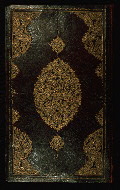
- Title: Binding
- Form: Binding
- Label: This dentelle-style brown goatskin binding with central lobed medallion, pendants, and cornerpieces is attributable to the tenth century AH / sixteenth CE.
Front flyleaf ia:
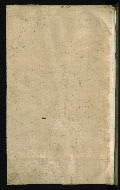
- Title: Flyleaf with inscription
- Form: Inscription
- Label: On this flyleaf is inscribed in pencil: H[enry] W[alters] May 1897, direct from Constantinople.
fol. 1a:
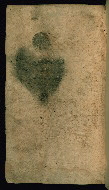
- Title: Page with erased seal of Sultan ʿUthmān Khān III
- Form: Seal
- Label: On this page is the erased seal of Sultan ʿUthmān Khān ibn Muṣṭafá Khān, who reigned from 1168-71 AH / 1754-57 CE and an erased bequest (waqf) inscription by Ibrāhīm Ḥanīf and his seal.
fol. 1b:
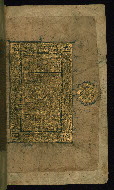
- Title: Right side of a double-page illuminated frontispiece inscribed with the creed that the Qur’an is God’s word uncreated
- Form: Frontispiece
- Label: This is the right side of a double-page illuminated frontispiece inscribed with the creed that the Qur’an is God’s word uncreated: al-Qur’ān kalām Allāh ghayr makhlūq wa-man qāla makhlūq fa-huwa kāfir bi-Allāh al-ʿAlī al-Aẓīm. This inscription is written in thuluth script.
fol. 2a:
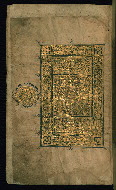
- Title: Left side of a double-page illuminated frontispiece inscribed with the creed that the Qur’an is God’s word uncreated
- Form: Frontispiece
- Label: This is the left side of a double-page illuminated frontispiece inscribed with the creed that the Qur’an is God’s word uncreated: al-Qur’ān kalām Allāh ghayr makhlūq wa-man qāla makhlūq fa-huwa kāfir bi-Allāh al-ʿAlī al-Aẓīm. This inscription is written in thuluth script.
fol. 2b:
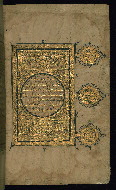
- Title: Right side of a double-page illuminated incipit for the first two chapters of the Qur'an
- Form: Incipit
- Text: Chapter 1 (Sūrat al-fātiḥah)
- Label: This is the right side of a double-page illuminated incipit. This page bears the seven verses of chapter 1 (Sūrat al-fātiḥah), written in a decorative New Abbasid (broken cursive) style.
fol. 3a:
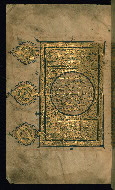
- Title: Left side of an illuminated double-page incipit
- Form: Incipit
- Text: Chapter 2 (Sūrat al-baqarah)
- Label: This is the left side of a double-page incipit with the initial verses of chapter 1 (Sūrat al-baqarah), written in a decorative New Abbasid (broken cursive) style.
fol. 3b:
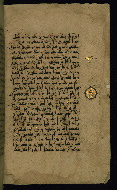
- Title: Text page with Qur'anic text written in New Abbasid (broken cursive) style
- Form: Text page
- Text: Chapter 2 (Sūrat al-baqarah)
- Label: On this text page, verses the Qur'an are written in the New Abbasid (broken cursive) style in dark brown ink with red dots for vowels and orthoepic signs, such as tashdīd and sukūn, in green. The name of Allah is illuminated in gold, as it is throughout the manuscript.
fol. 7b:
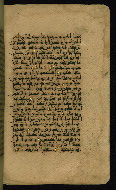
- Title: Illuminated text page with verses from chapter 2
- Form: text page
- Text: Chapter 2 (Sūrat al-baqarah)
- Label: On this text page from chapter 2 (Sūrat al-baqarah), the name of Allah is illuminated in gold, as it is throughout the manuscript. Verses are separated by an illuminated teardrop form.
fol. 11a:
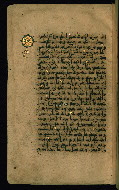
- Title: Illuminated text page with verses from chapter 2
- Form: Text page
- Text: Chapter 2 (Sūrat al-baqarah)
- Label: The text of this page is written in New Abbasid (broken cursive) style with red dots for vowels and orthoepic signs, such as tashdīd and sukūn, in green. The name of Allah is illuminated in gold, as it is throughout the manuscript; every tenth verse is indicated by an illuminated marginal medallion.
fol. 284b:
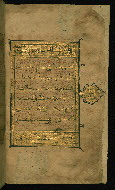
- Title: Right side of an illuminated double-page explicit
- Form: Explicit
- Label: This is the right side of an illuminated double-page explicit. The text is chapter 114 (Sūrat al-nās), which is written in a decorative New Abbasid (broken cursive) style.
fol. 285a:

- Title: Left side of an illuminated explicit with the creed that the Qur’an is God’s word uncreated
- Form: Explicit
- Label: This illuminated explicit is inscribed with the creed that the Qur’an is God’s word uncreated: al-Qur’ān kalām Allāh ghayr makhlūq wa-man qāla makhlūq fa-huwa kāfir bi-Allāh al-ʿAlī al-Aẓīm. It is written in a decorative New Abbasid (broken cursive) style.
The binding is not original.
Probably tenth century AH / sixteenth CE; dentelle-style brown goatskin (with flap); central lobed medallion, pendants, and cornerpieces
Erased seal of Sultan ʿUthmān Khān ibn Muṣṭafá Khān II (reg. 1168-71 AH / 1754-57 CE) and a bequest (waqf) inscription by Ibrāhīm Ḥanīf and his seal (fol. 1a)
Inscription in pencil: H[enry] W[alters] May 1897 direct from Constantinople (front flyleaf ia)
Principal cataloger: Gacek, Adam
Catalogers: Landau, Amy; Smith, Sita
Editor: Bockrath, Diane
Conservators: Jewell, Stephanie; Quandt, Abigail
Contributors: Barrera, Christina; Emery, Doug; Herbert, Lynley; Noel, William; Simpson, Shreve; Tabritha, Ariel; Toth, Michael B.; Valle, Chiara
The Walters Art Museum
Licensed for use under Creative Commons Attribution-NonCommercial-ShareAlike 3.0 Unported Access Rights, http://creativecommons.org/licenses/by-nc-sa/3.0/legalcode. It is requested that copies of any published articles based on the information in this data set be sent to the curator of manuscripts, The Walters Art Museum, 600 North Charles Street, Baltimore MD 21201.